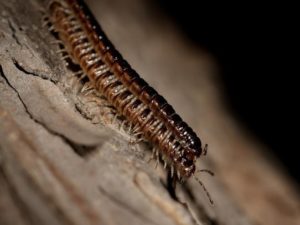 Millipedes may not present much of a threat to human beings, but they can still be a considerable annoyance in and around your home. These multi-legged creatures can infest houses, lawns, and gardens in enormous numbers, making your residence an unappealing place to live.
Millipedes may not present much of a threat to human beings, but they can still be a considerable annoyance in and around your home. These multi-legged creatures can infest houses, lawns, and gardens in enormous numbers, making your residence an unappealing place to live.
If you have limited experience with millipedes, you may not know what drives these pests into homes or what you can do to keep them at bay. To develop a better understanding of these odd-looking creatures, check out the answers to these frequently asked questions about millipedes.
What Do Millipedes Look Like?
Millipedes’ Latin-derived name implies that they have a thousand feet. While no millipede actually has this many feet, these creatures do tend to sport hundreds of legs arranged in symmetrical pairs. The millipede’s body features a cylindrical shape made up of many ringed segments. Most millipedes appear gray, black, or brown.
How Do Millipedes Differ From Centipedes?
At first glance, you might mistake a millipede for a centipede. Upon closer examination, however, you would see that millipedes have legs that face downward from their bodies, while centipedes’ legs extended outwards at a shallower angle. Centipedes also have longer antennae than millipedes.
You can determine whether you have centipedes or millipedes based in part on how these creatures behave. For example, millipedes generally move much more slowly than centipedes. Centipedes also bite, injecting venom into potential attackers or predators, while millipedes do not.
What Do Millipedes Eat?
Unlike many household pests, millipedes don’t take a primary interest in food or food leavings, preferring dead organic matter such as decaying leaves or wood. They will feast on lawn debris as well as gardening materials such as wood shavings or mulch. In the absence of dead vegetation, they will eat living plant matter.
Why Do Millipedes Invade Homes?
Millipedes require ready access to moisture. During exceptionally dry periods, these outdoor creatures may make their way into homes in their search for water. However, an excess of water (in the form of heavy rains or floods) can also drive millipedes to seek shelter indoors.
Millipedes who invade homes will gravitate toward the more humid areas of the residence. You may see them accumulated in laundry rooms, kitchens, bathrooms, damp basements, and rooms that suffer from poor humidity management.
What Can Millipedes Do to Humans?
Millipedes don’t usually harm humans. They do not appear to transmit diseases, nor do they transfer venom through painful bites as centipedes sometimes do. This essential harmlessness makes them more of a nuisance than a genuine threat to individuals and families.
Some millipedes do have the ability to defend themselves, however. They do this by secreting a foul-smelling chemical that apparently repels attackers and gives the impression that they would also taste as bad as they smell. Humans sensitive to this substance may develop skin irritation (including, in some cases, blisters) after touching a millipede.
How Do You Eliminate Millipedes From Your Home?
Millipedes will die off on their own after a few days if they cannot find sufficient moisture for their needs. You can limit the number of remaining millipedes by fixing any leaky fixtures in your home, improving outdoor drainage, and increasing the ventilation in humid parts of the house. Seal any cracks or gaps that permit pest infiltration.
To eliminate any possibility of irritating your skin, avoid picking up millipedes with your hands. Instead, vacuum or sweep them up into a sealable bag for disposal.
If you find your home is experiencing a large influx of millipedes, you may require professional pest control services. Your pest control expert will inspect the home to find probable entry points and recommend steps for sealing them. Chemical treatment at these entry points, and around outdoor moisture sources, can then kill the millipedes.
If you have a millipede problem that you want to get under control, A-Alert Exterminating Service Inc knows how to help. Contact us today to schedule a pest inspection and any other necessary pest control services.


